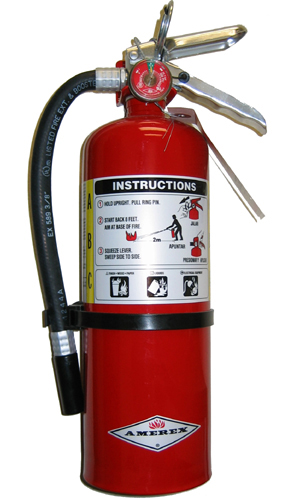The required locations for portable fire extinguishers are listed in the International Fire Code. It specifies both the spaces that are always required to have an extinguisher in the room and the number of extinguishers that you must have in the building.
 In Group A, B and E occupancies that are have quick response sprinklers, you only need them if you meet the other conditions. If you don’t have quick response sprinklers then you must have them.
In Group A, B and E occupancies that are have quick response sprinklers, you only need them if you meet the other conditions. If you don’t have quick response sprinklers then you must have them.
Any Group F, H, I, M, r-1, R-2, R-4 and S occupancies must have portable fire extinguishers. You also must have them within 30 feet of commercial cooking, in areas with flammable or combustible liquids, on each floor of buildings under construction and in special hazard areas that are specified by the fire code official. That gives them a great deal of leeway to require them. You also have to have them in a long list of spaces that include areas with flames, heated materials, aircraft servicing and fueling, dry cleaning, roofing, lumberyards, motor fuel, car repair, fabric structures, gas, fireworks. It a fairly common sense list.
The other piece is how much portable fire extinguisher you need.
If your fire potential is primarily from Class A fire hazards (wood, paper and trash) then you use Table 906.3(1). It states that in all cases you must be within 75 feet of an extinguisher (keep 75′ feet in mind, it can never be further). Then they talk about the type of hazard.
In a light hazard occupancy you must have a minimum 2-A extinguisher, it can cover 3,000 sf per A. So a 2-A fire extinguisher can cover 6,000 sf. The maximum floor area that can be covered by an extinguisher is 11,250. If you’re wondering that’s less than a 75′ radius circle and means you get nothing for more than a 4-A.
In an ordinary hazard occupancy you must have a minimum 2-A extinguisher, it can cover 1,500 sf per A. So a 2-A fire extinguisher can cover 3,000 sf. The maximum floor area that can be covered by an extinguisher is again 11,250.
In a extra hazard occupancy you must have a minimum 4-A extinguisher, it can cover 1,000 sf per A. So a 4-A fire extinguisher can cover 4,000 sf. The maximum floor area that can be covered by an extinguisher is again 11,250.
If your fire hazards are primarily Class B fire hazards (flammable liquid and gas) then you refer to Table 906.3(2). It correlates danger to distance and makes no mention of areas.
In a light hazard area a 5-B extinguisher must be within 30 feet or a 10-B must be within 50 feet.
In an ordinary hazard area a 10-B extinguisher must be within 30 feet or a 20-B must be within 50 feet.
In an extra hazard area a 40-B extinguisher must be within 30 feet or an 80-B must be within 50 feet.
If you have any questions about the number that will be required, look at section 906 of the International Fire Code and also speak to the Fire Marshal’s office. There is a fair amount of interpretation and you want to get the right cabinets and extinguishers in the correct locations.











2 thoughts on “Portable Fire Extinguishers in the International Fire Code”
Doesn’t say anything about how high or where the extinguisher must be mounted.
What is the requirement , by national fire code , as to office spaces with multiple entrances
Comments are closed.